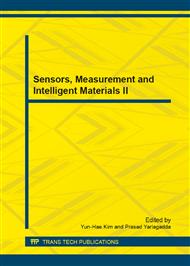p.1046
p.1050
p.1055
p.1060
p.1067
p.1071
p.1075
p.1079
p.1084
Solution Classification for Perspective-Three-Point Problem Base on PST Method
Abstract:
The perspective-n-point (PnP) problem is originated from camera calibration. It is to determine the position and orientation of the camera with respect to a scene object from n correspondent points. And a new stable algorithm by using a geometric constraint called perspective similar triangle (PST) can give new equations to solve P3P. The PST method achieves high stability in the permutation problem and in presence of image noise. Using the complete discrimination system, we obtain the solution classification of the new equation for the P3P problem. The solution classification gives a set of formulas to determine the number of real solutions to the P3P problem. Based on the formulas, we may know whether the parameters give multiple solutions or not and are critical or not which is very important to present robust algorithm.
Info:
Periodical:
Pages:
1067-1070
Citation:
Online since:
December 2013
Authors:
Price:
Сopyright:
© 2014 Trans Tech Publications Ltd. All Rights Reserved
Share:
Citation:


